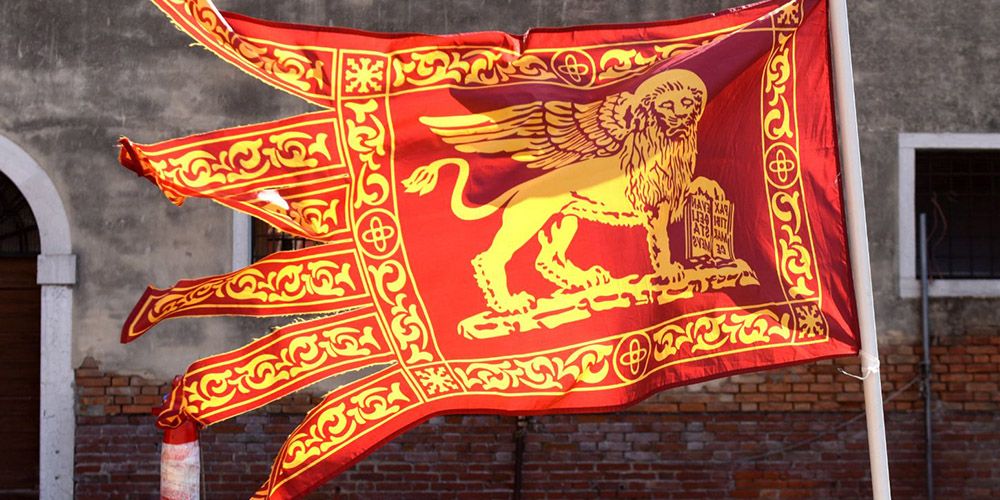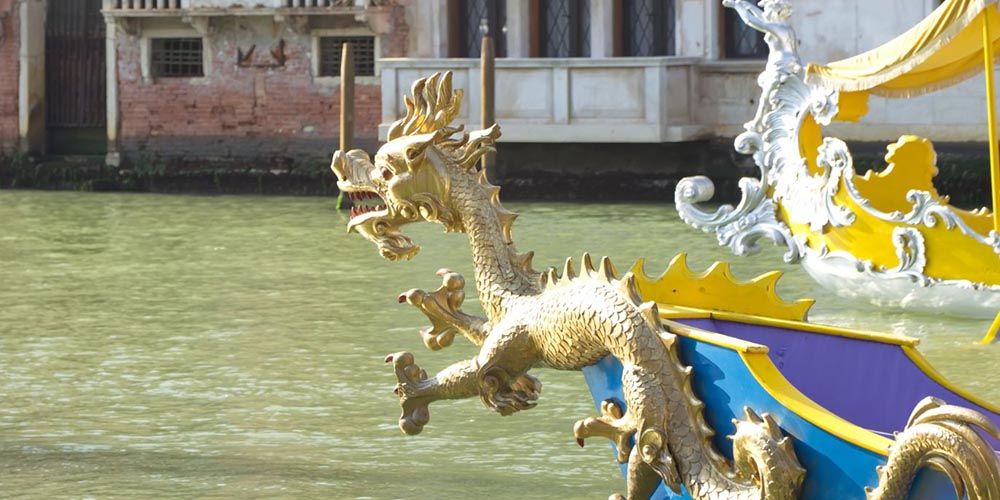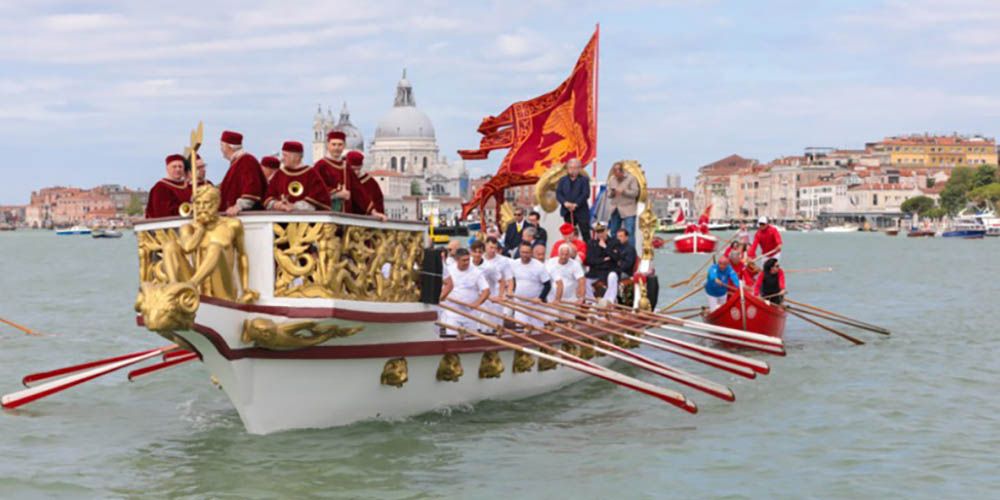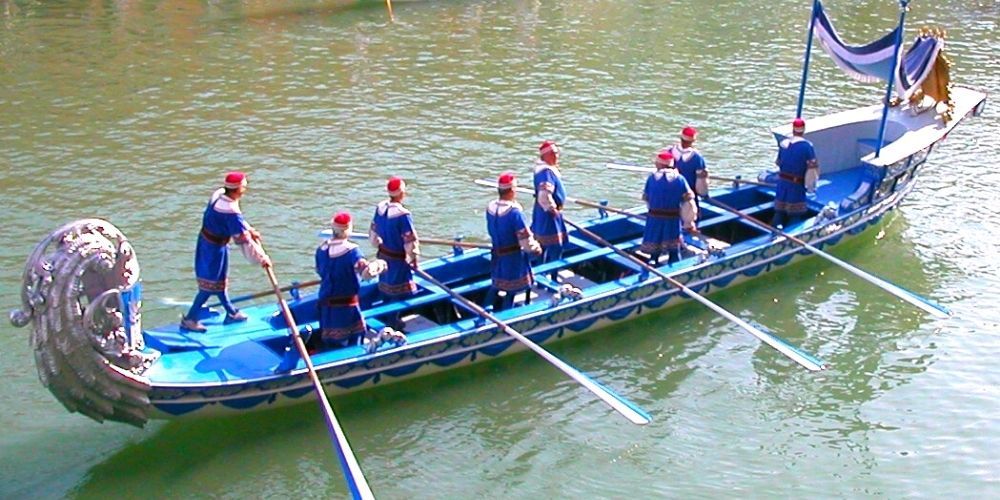Every Sunday following Ascension Day, Venice enacts an ancient ritual that originates from the days of the Serenissima, namely the Sensa Festival. The crucial moment is the marriage of the city of Venice with its sea, that sea that has guaranteed its prosperity and wealth for centuries. Even today, the Festa della Sensa attracts tourists from all over, who can enjoy the scenic ritual from a privileged point of view: the sea, of course.
To tell you more about this festival, that this year it is celebrated on June 1st 2025, we would go back in time. The Doges of Venice and the Serenissima will accompany us on this wonderful journey. And, if you've been thinking about taking a trip to Venice for this occasion, consider the Venice Pass, a unique card that will allow you to visit Venice's main attractions and have access to Venice's water transport.
The Ascension Day feast: a marriage between the city and the city or something more political?

As it often happened in the days of the Serenissima, the boundary between politics and religion was very blurred. The Feast of the Sensa, in fact, was celebrated on the Thursday following the fifth Sunday of Easter, on Ascension Day. Certainly the feast had relevance to this religious component but, in truth, it was primarily meant to celebrate the splendor, power and foresight of the Republic. In fact, the Feast was meant to celebrate two very important historical events for the Serenissima.
The first dates back to Ascension Day in the Year 1000, or 998 according to some, and features Doge Pietro II Orseolo. At that time, in fact, the Narentani, a population of Slavic origin with a reputation as pirates, hindered Venice's trade in the Adriatic. With the support of the Byzantine emperor, the Doge sailed to Istria and Dalmatia, visiting the main cities. He was greeted as a savior, except at Lastovo and Korcula, a den of pirates. The triumph of the enterprise, however, led Pietro II to bear the title not only Doge of Venice but also Duke of Dalmatia.
The second event, however, was in 1177, the year of the signing of the Peace of Venice, between the Lombard League and Barbarossa. In that case, too, Venice showed its refined diplomacy. Siding with neither side in the dispute, it offered the city as a neutral place for negotiations. While agreement was reached, Venice also had its comeuppance. It had finally been recognized as one of the great powers of the time.
While there is therefore very little religious about the Feast of the Sensa, we are now ready, however, to be seduced by the pageantry of one of the most celebrated festivals on the Venetian calendar.
Preparation on the eve of the Feast
If this festival does not say much to many Venice enthusiasts, it is maybe because of the different point of view from which it can be observed. And it could not be otherwise. The Festa della Sensa is in fact observed from the sea. It all began at the time of the Peace of Venice, when Pope Alexander III granted the Doges to actually marry the sea, a clear sign of the Republic's dominance over it. At that time, however, a similar, Byzantine-style festival was organized in Venice on Ascension Day. It commemorated the famous victory over the Narentans. In any case, the festivities were much longer than just one day.
The Sensa Fair, in fact, was set up a week before Ascension Day and discontinued only 15 days later. This time the background of the fair was religious, as Venice was a gathering point for pilgrims to the Holy Land.
The actual Festa, however, began on the day of the eve, when the famous Bucintoro, the state galley, was brought from the Arsenal to Riva degli Schiavoni. The beautiful ship was decorated and, at the same time, the ships that would participate in the parade the next day were adorned and taken to the stretch of sea between Venice and the Lido. The homes of the Venetians were also decorated, and in the evening it was a triumph of bells that officially ushered in the start of the festival. Everything was finally ready for the incredible day of the Ascension.
The Ascension Day: the navigation to Lido with great pomp

On Ascension Day, the Doge and his court would leave the Doge's Palace, greeted by the clanging of bells. The procession, preceded by a band, then reached the Riva degli Schiavoni, where they boarded the Bucintoro. A cannon shot in the square and a series of cannonades from the naval ships announced that the Bucintoro had set sail and was sailing in the direction of the Lido.
Along with the Bucintoro, 3 peatoni, golden boats always associated with the ship of state, and the golden gondolas of the ambassadors and the Patriarch of Venice also plied the waters. And that was not all. 6 galleys and 12 smaller ships carried the marching band and a small group of Dalmatian soldiers in parade uniform, while some medium-sized boats carried representatives of the different communities of the city territory.
Finally, boats and gondolas of all private individuals who wished to attend the ceremony followed. Everything was ready for the crucial part of the day to take place.
The Festa della Sensa and the Marriage of Venice with the Sea

Here we are at the most solemn moment. The boats had now reached the Lido, and the Bucintoro was anchored near the Church of St. Nicholas, patron saint of sailors.
It was time to pray for the sea to be always benevolent and protect Venice and its inhabitants. Then the Doge and his court were sprinkled with the blessed water, in the presence of the Patriarch. As the cannons continued to explode all around, the Doge, always flanked by the Patriarch, held up the blessed ring and let it slip into the water, with these solemn words:
"Desponsamus te, mare. In signum veri perpetuique dominii." That is, "We marry you, mare. As a sign of true and everlasting domain."
This was the most political sign of all. Although it was probably granted by the Pope in 1177, although the Patriarch was there, the gesture in fact was meant to reaffirm to the whole world the economic and military power of the Republic of Venice.
Apparently, a probable ducal ring is kept in the Treasury of St. Mark's Basilica to commemorate this ceremony. At that point, the Doge and his court would disembark at the Lido and attend Mass. The most fun part took place outside, however.
There were speed contests between gondolas, and the people could dress up in masks and pageantry like at Carnival. The occasion was also tempting for lavish lunches in private residences. After the Mass was over, it was back to Venice, where the Doge visited the Sensa Fair, and the feast continued with a banquet at the Doge's Palace.
The meal was impressive, and even some representatives of the people were admitted to the first part. At the end, it seems that the guests were even allowed to take the dishes home with them, in memory of the wonderful day. But what about the Feast of the Sensa today?
The Festa della Sensa 2025

This year, the event that celebrates the thousand-year-old meeting between Venice and the Sea and the practice of Venetian rowing will take place on Sunday, June 1, 2025. The program begins with the Regattas at 9:45 in the morning, in this group of regattas the very young will participate on the 2-oared pupparini, the women on the 2-oared mascarete and the men on the 4-oared gondolas. The traditional water procession of the Sensa will instead start at 10:00 from San Marco dei Giardinetti to San Nicolò al Lido, with the Bucintoro at the head of the parade, immediately followed by the Serenissima, which was the state ship of the Doges of the Venetian Republic and which is now occupied by the Mayor of the city. The ceremony of the marriage with the sea and the traditional throwing of the ring will be celebrated at 10:40 in front of the church of San Nicolò al Lido. The choir will then perform and mass will be held.
But it doesn't end there, as in ancient times, alongside the institutional ceremonies, starting at 10:00 on Saturday 31 May 2025 and until 20:00 at the Lido di San Nicolò the traditional Sensa markets will be set up and initiatives will take place, such as the fishing event and at 10:00 at the Capli beach an interesting exploration of the coast with the collection of materials brought by the sea conducted by UNESCO experts and aimed at families. Visiting Venice for the amount of opportunities and unmissable attractions can be tiring, we suggest you once again to take advantage of a Pass that will make your visit much easier, such as the Venice Pass, which in addition to access to the main attractions, will allow you to take advantage of fantastic opportunities.
Sensa Festival Program
Saturday, May 31, 2025 10:00 - 20:00
Traditional Sensa Markets
Sporting Initiatives and Events
Sunday, June 1, 2025
10:00 Sensa Procession starting from San Marco dei Giardinetti (Riva degli Schiavoni)
10:40 Marriage Ceremony with the Sea Church of San Nicolò al Lido
11:00 Choir Church of San Nicolò al Lido
11:15 Mass Church of San Nicolò al Lido










Lascia un commento